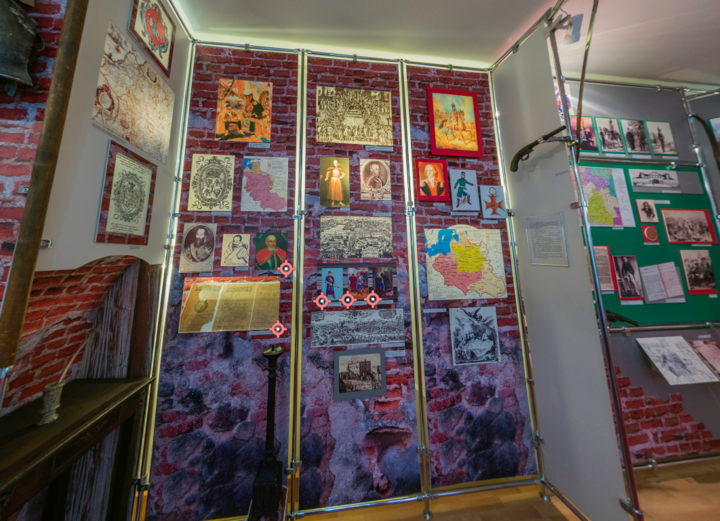This Is What You Can See During Virtual Tour To KGB Museum In Minsk
TUT.BY / BelarusFeed
14 December 2017, 15:16
 Ever wanted to take a glance at one of the most secret intelligence force hub? Now you can take a virtual tour to the museum of Komitet Gosudarstvennoy Bezopasnosti also known as the KGB in Minsk.
Ever wanted to take a glance at one of the most secret intelligence force hub? Now you can take a virtual tour to the museum of Komitet Gosudarstvennoy Bezopasnosti also known as the KGB in Minsk.
A virtual tour to the museum which is usually closed for the ordinary people became available on the website of the State Security Committee of Belarus.
Navigation allows one to move up, down, right and left, zoom in and out the image, or to set it full screen.
The virtual visitor can travel from one hall to another using the “show plan” button located in the upper left corner.
There are twelve halls in the museum each dedicated to some specific historical era.
The first room is devoted to the Principality of Polotsk (8-13th century).
One can see maps of the state, manuscript miniatures, as well as variuos paintings that depict major events of this period.
The second room narrates the story of the Grand Duchy of Lithuania and Polish–Lithuanian Commonwealth (13-18th centuries).
Apart from eminent historical figures there is information about personalities who were engaged in intelligence service of that time.
The history of Belarus as a part of the Russian Empire is at the third hall of the museum, where one can find portraits of Kastus Kalinouski, Emilia Plater and Ignacy Hryniewiecki.
The fourth hall tells about the first steps of the Soviet state security agencies, the fifth hall is devoted to the 1930s and the sixth is about intelligence service alone.
In the seventh, eighth and ninth halls the tourist can get acquainted with the Great Patriotic War events, rare memorabilia and heroes.
The fight against the Organization of Ukrainian Nationalists during the post-war year is at the tenth room, while the post-war reconstruction periosd is in the eleventh.
The twelfth room tells about the times of the Khrushchev Thaw, stagnation and perestroika, as well as the KGB search for the war criminals.
The thirteenth hall is dedicated to the war in Afghanistan. And finally, the fourteenth hall is about the present time.
Here one can see the portrait of President Alexander Lukashenko and also learn about the participation of the KGB officers in the reconstruction of the cross of St. Euphrosyne of Polotsk.
14 December 2017, 15:16

A virtual tour to the museum which is usually closed for the ordinary people became available on the website of the State Security Committee of Belarus.
Navigation allows one to move up, down, right and left, zoom in and out the image, or to set it full screen.
The virtual visitor can travel from one hall to another using the “show plan” button located in the upper left corner.
There are twelve halls in the museum each dedicated to some specific historical era.
The first room is devoted to the Principality of Polotsk (8-13th century).
One can see maps of the state, manuscript miniatures, as well as variuos paintings that depict major events of this period.
The second room narrates the story of the Grand Duchy of Lithuania and Polish–Lithuanian Commonwealth (13-18th centuries).
Apart from eminent historical figures there is information about personalities who were engaged in intelligence service of that time.
The history of Belarus as a part of the Russian Empire is at the third hall of the museum, where one can find portraits of Kastus Kalinouski, Emilia Plater and Ignacy Hryniewiecki.
The fourth hall tells about the first steps of the Soviet state security agencies, the fifth hall is devoted to the 1930s and the sixth is about intelligence service alone.
In the seventh, eighth and ninth halls the tourist can get acquainted with the Great Patriotic War events, rare memorabilia and heroes.
The fight against the Organization of Ukrainian Nationalists during the post-war year is at the tenth room, while the post-war reconstruction periosd is in the eleventh.
The twelfth room tells about the times of the Khrushchev Thaw, stagnation and perestroika, as well as the KGB search for the war criminals.
The thirteenth hall is dedicated to the war in Afghanistan. And finally, the fourteenth hall is about the present time.
Here one can see the portrait of President Alexander Lukashenko and also learn about the participation of the KGB officers in the reconstruction of the cross of St. Euphrosyne of Polotsk.



